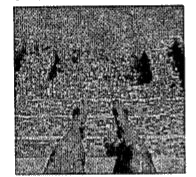Name the three constituents of an atom and state mass and charge of each. How are they distributed in an atom ?
To answer the question about the constituents of an atom, their mass and charge, and how they are distributed, we can follow these steps:
Step 1: Identify the three constituents of an atom
The three main constituents of an atom are:
1. Electrons
2. Protons
3. Neutrons
Step 2: State the mass and charge of each constituent
- Electrons:
- Mass: me=9.1×10−31 kg
- Charge: qe=−1.6×10−19 coulombs (negative charge)
- Protons:
- Mass: mp=1.672×10−27 kg
- Charge: qp=+1.6×10−19 coulombs (positive charge)
- Neutrons:
- Mass: mn=1.675×10−27 kg
- Charge: qn=0 coulombs (no charge)
Step 3: Describe the distribution of these constituents in an atom
- Protons and Neutrons: These particles are located in the nucleus, which is at the center of the atom. The nucleus is dense and contains most of the atom's mass.
- Electrons: Electrons are found in regions around the nucleus known as electron shells or energy levels. They move in circular orbits around the nucleus, creating an electron cloud.
Final Summary
In summary, an atom consists of three constituents: electrons (with a mass of 9.1×10−31 kg and a charge of -1.6 x 10−19 C), protons (with a mass of 1.672×10−27 kg and a charge of +1.6 x 10−19 C), and neutrons (with a mass of 1.675×10−27 kg and no charge). Protons and neutrons are located in the nucleus, while electrons are distributed in orbits around the nucleus.
---
The three main constituents of an atom are:
1. Electrons
2. Protons
3. Neutrons
- Electrons:
- Mass: me=9.1×10−31 kg
- Charge: qe=−1.6×10−19 coulombs (negative charge)
- Mass: mp=1.672×10−27 kg
- Charge: qp=+1.6×10−19 coulombs (positive charge)
- Mass: mn=1.675×10−27 kg
- Charge: qn=0 coulombs (no charge)
- Protons and Neutrons: These particles are located in the nucleus, which is at the center of the atom. The nucleus is dense and contains most of the atom's mass.
- Electrons: Electrons are found in regions around the nucleus known as electron shells or energy levels. They move in circular orbits around the nucleus, creating an electron cloud.
In summary, an atom consists of three constituents: electrons (with a mass of 9.1×10−31 kg and a charge of -1.6 x 10−19 C), protons (with a mass of 1.672×10−27 kg and a charge of +1.6 x 10−19 C), and neutrons (with a mass of 1.675×10−27 kg and no charge). Protons and neutrons are located in the nucleus, while electrons are distributed in orbits around the nucleus.
टॉपर्स ने हल किए ये सवाल
- RADIOACTIVITYBook:ICSEChapter:RADIOACTIVITYExercise:MULTIPLE CHOICE TYPE
Explore 6 Videos
- RADIOACTIVITYBook:ICSEChapter:RADIOACTIVITYExercise:EXERCISE-12(B)
Explore 19 Videos
- RADIOACTIVITYBook:ICSEChapter:RADIOACTIVITYExercise:NUMERICALS
Explore 2 Videos
- QUESTION PAPER-2019Book:ICSEChapter:QUESTION PAPER-2019Exercise:SECTION-II
Explore 42 Videos
- REFRACTION OF LIGHTBook:ICSEChapter:REFRACTION OF LIGHTExercise:DIAGRAM BASED MCQ:
Explore 5 Videos
समान प्रश्न
A radioactive substance emits radiations :
View SolutionWhat do you mean by nuclear energy ? What is responsible for its release ?
View SolutionIn fission of one uranium-235 nucleus, the loss in mass is 0.2 a.m.u. Calculate the energy released.
View SolutionA body of mass 10 kg is kept at a height of 5 m. It is allowed to fall and reach the ground.
What is the total mechanical energy possessed by the body at the height of 2 m assuming it is a frictionless medium ?
View SolutionName the phenomenon occurring in the following figure:

View SolutionA coording to Thomson model, the entire mass and positive charge of an atom are distributed.............in a..............of radius.......... .
View SolutionIn the Thomson's model of atom, which of the following statement are correct ? (i) The mass of the atom is assumed to be uniformaly distributed over the atom. (ii) The positive charge is assumed to be uniformaly distributed over the atom. (iii) The electrons are uniformaly distributed in the positively charged sphere. (iv) The electrons attract each other to stabilise tha atom.
View SolutionName the three sub-atomic particles of an atom.
View SolutionAn element has atomic number 13 and an atomic mass of 27
(a) How many electrons are there in each atom of the element ?
(b) How are these electrons distributed in the various energy levels ?
View SolutionHow is the distribution of electrons in the atoms of an atom? Describe
View SolutionCompare the relative mass and charge of the three fundamental sub-particle of an atom .
View SolutionWhat are the three subatomic particles ? (AS1)
View SolutionName the three sub-atomic particles of an atom.
View SolutionIn the Thomson's model of atom, which of the following statement are correct ?
(i) The mass of the atom is assumed to be uniformaly distributed over the atom.
(ii) The positive charge is assumed to be uniformaly distributed over the atom.
(iii) The electrons are uniformaly distributed in the positively charged sphere.
(iv) The electrons attract each other to stabilise tha atom.
View SolutionWhich constituent particles of the atom determine (i) the mass of the atom (ti) the size of the atom ?
View Solution